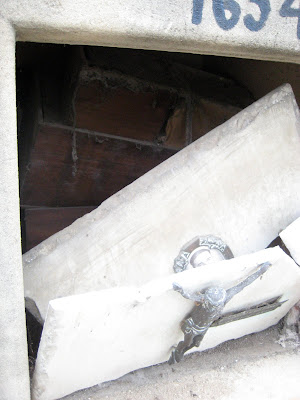Destinations: Montevideo and Colonia, Uruguay, and Buenos Aires, Argentina
Total Spent on Buses/Boat: $253
Total Hours Spent on Buses/Boat: 33
After an overnight, twenty-hour bus ride from Florianópolis, Brazil, to Montevideo, Uruguay, my girlfriend and I spend New Year's Eve with her second cousins. They break out Johnnie Walker whiskey (whiskey is really expensive in South America––an $18 bottle Jack Daniels ranges from $58 in Brazil to $26 in Argentina), liters of beer, bottles of wine, various meats piled on a cutting board (and eaten with shared forks), mixed nuts, and a stack of these wonderful, thin, crustless sandwiches, called sandwiches de miga.
Though Uruguay is supposed to be a poor country, they know how to celebrate. The young residents of Montevideo hit the streets midday New Year's Eve for a street party. People play drums and shout and sing. Almost everyone carries a green plastic bottle of inexpensive cider, which they drink and splash on each other, and then throw the empty bottles at buildings or into the streets (you can see pictures on this blog––be sure to scroll down through all the pictures). Also, when you're walking down the sidewalks, residents dump buckets of water from buildings onto unsuspecting revelers and tourists alike, washing or baptizing you for the New Year, I guess. And the streets are littered with people's daily calendars, which they've thrown into the street like parade confetti. In late afternoon, everyone goes home and the streets look abandoned.

Then, at midnight, the city explodes with fireworks ( fuegos artificiales). It's not like the U.S., where people sit around watching an isolated, choreographed fireworks show or light off a few firecrackers and Whistling Petes, though that's done as well. It's more participatory, and everyone lights their own skyward bound fireworks around the city, which has an incredible war zone effect. The explosions last a straight fifteen to twenty minutes, during which time some residents emerge from their homes and burn their wall calendars in the streets. Such a cool, symbolic gesture.
A couple days later, my girlfriend goes to visit her grandmother and uncle in Trinidad, and I head for Colonia del Sacramento, then Buenos Aires. Before I leave Uruguay, I email Daniel Chacón (books by this author), a frequent Buenos Aires visitor, to ask him about cool places I can check out. He emails back, telling me I can just come visit him and his wife, Sasha Pimental Chacón (book by this author), because they're in Buenos Aires right now. I'm telling you all this because when I meet up with them they take me to Cementerio de La Chacarita where the contrasts between the rich and poor couldn't be sharper.
Just past the neoclassical entrance to the cemetery the visitor is greeted by a neighborhood of wealthy family tombs, complete with sculptures and yellowish, brick sidewalks. It's unquestionably beautiful, but, as Sasha points out, a little excessive for the dead, who don't need these elaborate coffin houses.
After being reprimanded for taking photos by a security guard, Daniel says he's not interested in this section of the cemetery; he wants to show me and Sasha "the Bronx" of the cemetery. So we walk. Through a park-like section with white crosses, tall trees, and mosquitoes that attack us (the suburbs); then through what looks like a strange park with cement ventilators sticking out of the lawn and staircases leading into a post-apocalyptic underground section. Down here, we wander through hallways of semi-rusting, filing cabinet-like walls that house coffins (I guess this would be the lower-middle-class apartments).
We keep walking toward the back of the cemetery, where we take time to inspect the partitioned "Berlin Wall" that houses family ashes.
These less expensive and smaller apartments for ashes are in various states of disrepair, some you can't even read anymore, and there's a whole section of the wall supported by wooden braces. Pigeons rest in the apartment doorways, and some marble wall tablets are broken, revealing wooden boxes of ashes and spiderwebs inside.
We follow the wall to the right around the edge of the cemetery, and finally arrive in "the Bronx": a completely unkempt area of hilly dirt, littered with weeds and broken crosses. This is where the poor have come to rest, in death as in life.
The only consolation for the poor is that they've been returned to the earth, while the wealthy hover on shelves above or below the ground, never quite returning to their source. What they don't realize is that everything fades, even red velvet chairs and ornate coffins. Their money might have bought a little more time above ground, but, as you can see, everything eventually turns to dust.











No comments:
Post a Comment